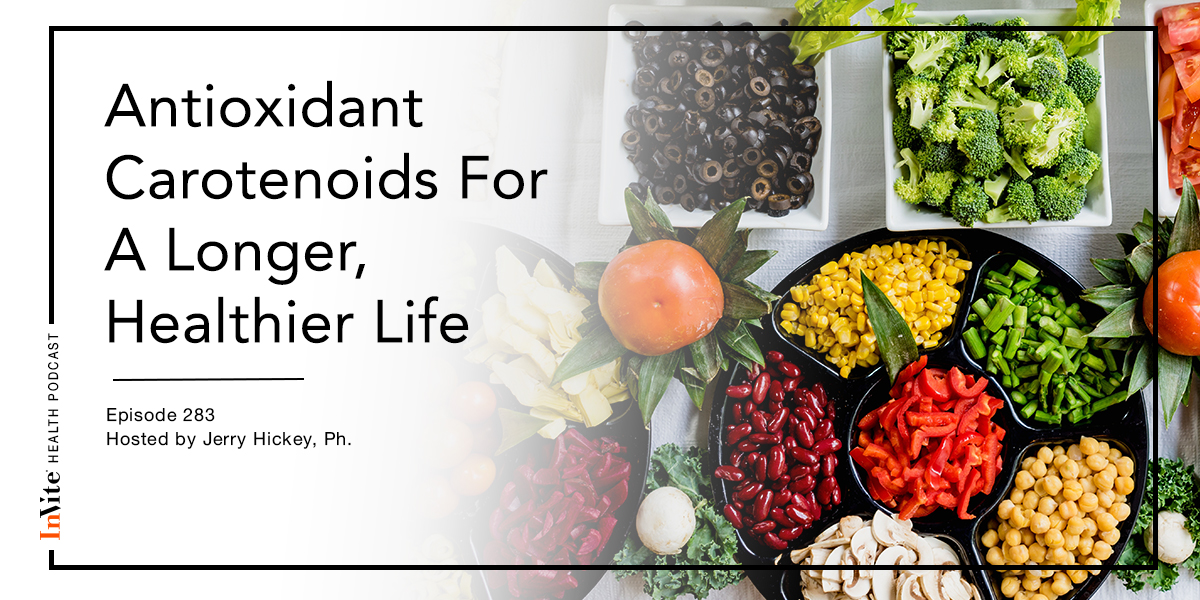Antioxidant Carotenoids For A Longer, Healthier Life – InVite Health Podcast, Episode 283

carotenoids
Invite Health Podcast, Episode hosted by Jerry Hickey. Ph
Subscribe Today!
Carotenoids are colorful pigments from plants. They’re found in fruits and vegetables. Based on reading thousands of studies spanning decades, I truly believe that if you consume a broad variety of these pigments, they lend to a longer and healthier life. I’d like to talk to you today about how you can include carotenoids in your diet by eating the rainbow and taking supplements, as well as the benefits this will give.
Lycopene
A good example of these health-promoting effects would be Lycopene. Lycopene is a red pigment. People know it from tomatoes and tomato sauce. If you eat a tomato, you do get some Lycopene, however when you cook it down, you’re breaking down the fibers and releasing the Lycopene so it’s easier to absorb. Plus, when people tend to convert tomatoes into tomato sauce, they’re adding some olive oil, which is a fat that helps you absorb Lycopene because all of these carotenoids are fat-soluble. If you take them with other foods that are fatty, you absorb them better. Lycopene is a red pigment that you get in ripe mangoes and papayas. You get a little bit in strawberries, any red fruit, but the biggest source in the American diet is tomatoes.
Lycopene has shown great benefit for helping slow down aging of the skin, making the skin softer and giving it a nice pigment. When you eat carotenoids from your fruits and vegetables, they give your skin this underlying healthy glow. The Lycopene helps shield your skin from the sun, which has damaging and aging effects. Lycopene has also been shown to have a really nice effect in protecting your vascular system and supporting overall heart health.
Research on carotenoids
We’ve known for several decades that two pigments, Lutein and Zeaxanthin, are important for vision, but over the past several years, there’s been really groundbreaking research that they’re also important for the aging brain. But let me give you a caveat: absorption of these pigments from food declines with age, so when you’re older, you can eat a lot more vegetables and fruit, but it’s also a smart idea to add a good quality source as a supplement of natural carotenoids.
Lutein and Zeaxanthin have been shown in a lot of research to bolster not just eye health, but also cognitive function and cognitive health in older adults. In a study from the University of Georgia, researchers used functional MRI technology to see how different levels of carotenoids affect the function of the brain in older adults. They looked at the brain activity of more than 40 adults between the ages of 65 and 86 while they were attempting to recall word pairings that they were taught earlier in the day. This puts a certain amount of strain on the brain that can be picked up by the functional MRI. It also shows you how these parts of the brain light up and if they’re functioning well. The researchers found that in individuals with higher levels of Lutein and Zeaxanthin, the brain didn’t have to work as hard to get the job done. The brain was more effective and efficient and was working more easily, like a much younger brain.
One of the researchers from the University of Georgia said, “There’s a natural deterioration process that occurs in the brain as people age, but the brain is great at compensating for that. One way it compensates is by calling on more brain power to get a job done so it can maintain the same level of cognitive performance.” In other words, just to make up an example, if a young person was using 1% of their brain to get the job done and an older person might have to use 2 or 3% of their brain to get the same job done, but that doesn’t have to happen when they have the pigments.
For more research on the important function of carotenoids, tune into the full podcast episode.
Eat The Rainbow of Colors For Good Health – InVite Health Podcast, Episode 261
How to get more carotenoids
What can you do to make sure you’re getting more of these pigments? Eat the rainbow. For instance, Lutein is an orange pigment. It’s in green leafy vegetables. You don’t see it because the chlorophyll, which is green, hides it, but it’s in there. When you eat your spinach and broccoli, you’re getting it. Pistachio nuts have a little bit. Zeaxanthin is yellow and you get it in things like corn. Lycopene is red and the best source is tomato sauce. Astaxanthin is pink. The easiest way to get Astaxanthin is to have some Krill Oil capsules. They have natural Astaxanthin. Beta Carotene is amber, but it’s pretty ubiquitous in fruits and vegetables, so it’s easy to get that. If you can eat a cross section of different vegetables and fruits, you’re getting a cross section of all these different pigments.
We use a cross section of natural carotenoids that have been used in human clinical trials in our multivitamins. We include Alpha Carotene, Lutein, Zeaxanthin, Lycopene, Astaxanthin and natural Beta Carotene.
Thank you for tuning in to the Invite Health Podcast. You can find all of our episodes for free wherever you listen to podcasts or by visiting www.invitehealth.com/podcast. Make sure you subscribe and leave us a review! Follow us on Facebook, Twitter and Instagram at Invite Health today. We’ll see you next time on another episode of the Invite Health Podcast.


